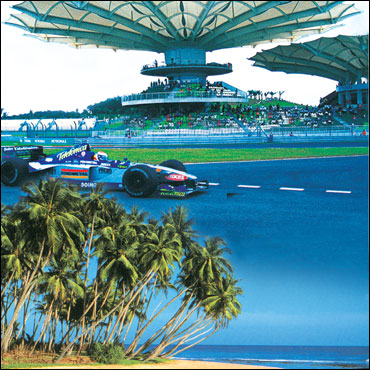France is the world’s most popular tourist destination, attracting an astounding 77 million tourists in 2002, substantially more than its 60 million population. In second place was Spain with 51.7 million visitors and third was the United States with 41.9 million.
The others in the top 10 rankings were Italy (4th), China (5th), United Kingdom (6th), Canada (7th), Mexico (8th), Austria (9th) and Germany (10th).
Six of these top 10 countries are from Europe, which in 2002 enjoyed the lion’s share of international tourist arrivals, taking in 400 million visitors or 56.9 per cent of the world’s total.
The Asia and Pacific region came in second, with 131 million tourists or 18.7 per cent, followed by the Americas (115 million or 16.4 per cent) which suffered a decline in visitors after the September 11 incident hit inbound tourism into the US.
At the bottom of the preferred tourist regions were Africa (29 million or 4.1 per cent) and the Middle East (28 million or 3.9 per cent).
What is immediately obvious from this list of the top tourist destinations is that, with the exception of China and Mexico which are poised to break out of their developing country mould, the rest are all highly developed countries.
It is also very revealing that the eight advanced countries that drew the most number of international tourists are ranked among the top 30 most innovative nations in the world by the World Economic Forum for last year. Apart from Italy, which was in 41st position, the other seven also made it to the top 30 in the WEF’s Global Growth Competitiveness Index.
Italy’s ranking was pulled down by low scores due to economic problems and poor perceptions of public institutions. The performance of the most successful countries and regions in international tourism underscores the fact that the most successful nations in the world are also the most creative and innovative.
These are all high quality and, more significantly, high cost countries. Yet many tourists are willing to spend more to visit them. It clearly demonstrates that being cheaper may not make countries more popular with tourists.
What travellers want is a good time, not a hard time. And the advanced countries have just what they need to have a good time – comfort, safety, efficiency, facilities.
Malaysia has what it takes to draw international tourists
Malaysia already has many of the features of a developed country, with excellent infrastructure that provides convenient and fast transport, five-star hotel comfort, and a clean and safe environment. Communication with the local people is easy as English is widely spoken and understood.
We host the most number of world-class sports and adventure events in Asia and these attract tens of thousands of locals and foreigners. They include the F1 Grand Prix, F1 Power Boat Race, World Motor Cycle Grand Prix, Le Tour de’ Langkawi and Mount Kinabalu Climbathon.
The facilities and the ability to organise international events efficiently are all indications of a creative people, an innovative nation. Malaysia does not lack for tourism products. If anything, we have an oversupply of them. Tourists are spoilt for choice.
Sabah has Mount Kinabalu, the tallest peak in Southeast Asia, and Pulau Sipadan, a world-class diving haven; Sarawak is renowned for its mix of rich ethnic cultures and a colourful colonial past; Malacca has a unique legacy of Portuguese, Dutch and British influences that live on in the people and architecture; Pahang offers eco-tourism and the tranquility of island and hill resorts; Penang has an unrivalled old world charm; Pulau Langkawi is Malaysia’s premier island resort with miles of white sandy beaches; and cosmopolitan Kuala Lumpur is the centre of Mega Sales Carnivals and MICE (meetings, incentives, conventions and exhibitions) activities.
International travellers have responded well to Malaysia. Last year, we hosted 10.58 million foreign tourists. The arrivals were down from the 13.3 million who came in 2002 because of the outbreak of Severe Acute Respiratory Syndrome (SARS) and war in Iraq, but still higher than the 10.2 million in 2000.
Tourism brought in RM21.3 billion last year, making it the country’s second highest foreign exchange earner after manufacturing.
Going forward, Malaysia needs to tap into the natural tendency of tourists to explore new areas in search of a unique travel experience.
As the world’s population continues to grow, and as more tourists are drawn to the first world countries, it is inevitable that the most popular vacation and tourist destinations will become more crowded.
In time, the focus of world tourism will switch to new destinations that have the right facilities and the right country profile. Malaysia has it all. We only need to be more innovative in what we do, in the way we do it and in the way we sell it.
Targeting the high-yield visitors creatively
Innovative packages should be in place and targeted at high-yield travellers. These will include business people, international students and people seeking healthcare.
Western business people take the phrase “business cum pleasure” seriously. They travel not just for work, and they certainly do not travel to places which do not have the conveniences and comfort they desire.
International education is another growing contributor to tourism.
In the past, most students from developing countries who go overseas to seek a higher education chose one of the Big Five countries – the United States, United Kingdom, Canada, Australia and New Zealand. Now they come to Malaysia as well.
Any country that provides international education, and attracts many foreign students, is an admired country. It has a positive country brand image.
Today, we have close to 40,000 foreign students studying in schools and tertiary institutions in the country, and they come from more than 150 countries.
That means many people around the world have confidence in our country and our systems. Otherwise, they will not come here or send their children to be educated here. And when these parents speak of Malaysia and speak of their daughters and sons being educated in Malaysia, we cannot get any better promoters than them.
Foreign students are here for three to four years. In other words, they are semi-permanent visitors. They bring their parents, siblings and friends here as well. And more students from their countries will follow.
In healthcare, Malaysia is promoting the country as a regional centre for modern, efficient and affordable medical treatment.
In 2002, the number of patients seeking treatment rose to nearly 192,000 from 78,000 in 2000.
Building a consistent, constant country image
Malaysia has so much to offer visitors. But it has no easily identifiable brand image to offer.
The current Malaysia Truly Asia theme has generated interest and facilitated recall by tourists planning a choice of vacation destinations. But we need to move on and be more focused in our promotion.
It is time to have a strategy to promote a single strong theme, creatively and innovatively woven into an image of a unique, memorable and satisfying country to have a holiday.
We can have many second images but there will be one key image, one key message that people around the world will know of and speak of when speaking of Malaysia.
If the Petronas Twin Towers is the choice, then it should be promoted constantly. We can refresh the theme every year, but the central image must be constant.
It should be Truly Malaysian. It is worth noting that most of the world renowned tourism icons – the Eiffel Tower, Taj Mahal, Little Mermaid, Big Ben, Statue of Liberty – have been promoted for a very long time. These popular tourist destinations also have simple but creative messages. And these messages always carry the promise of having fun and a good time. Unless we get on with being as creative and innovative in our focus as them, we risk being left behind.

